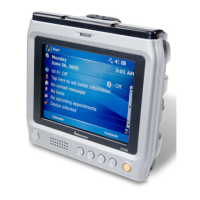Chapter 3 — Theory of Operation
54 CV30 Fixed Mount Computer Service Manual
This power is the PFET controlled and ferrite filtered version of the
V3P3_AUX by the signal nCF_PWR_EN_PF. This signal is asserted when
the condition of both CF_PWR_EN and nBATT_FAULT_DET is at
Logic H. The V3P3_CF powers up the radio module attached to the CF
connector.
V3P3_BT
V3P3_AUX To V3P3_BT
This power is the PFET controlled version of the V3P3_AUX by the signal
nBT_PWR_EN_PF. This signal is asserted when the condition of both
BT_PWR_EN and nBATT_FAULT_DET is at Logic H. V3P3_BT
supplies power to the Bluetooth module.
V3P3_TXCVR
V3P3_AUX To V3P3_TXCVR
This power is the PFET-controlled and ferrite-filtered version of the
V3P3_AUX by the signal nETH_EN and nCF_PWR_EN_PF. Either of
these signal when asserted, makes V3P3_TXCVR available to the
transceivers.
Backup Power System
The CV30 contains a single cell, Lithium-Ion battery to support the
backup power system during the critical suspend state. The system
monitors the external supply. When the system detects that the external
supply is below a preset limit of 8 V or detached from the terminal, the
system switches over to the internal battery, removes power to high current
loads, and signals the operating system into critical suspend. The fully
charged battery has a capacity 2400 mAh which is enough to support a
graceful shutdown, and then supply suspend current to the unit to support
the emergency suspend state for at least 72 hours. If external power is
restored, the CV30 will resume the state it was in when power was
removed.
There is an internal protection circuitry within the battery pack to protect
the battery from:
• Over discharge. When the battery voltage has reached a point
(2.20~2.40 V) at which further discharge will damage the cell, the
internal FETs turn off to prevent further discharge of the battery. The
battery can no longer provide power. Once the battery internally
disconnects, charge voltage must be applied to the pack to recover or to
turn the internal protection FET back on. This voltage is required
before the internal protection circuitry of the battery allows power to
come in or go out of the battery.
• Over-voltage charging. If the battery is overcharged, its cell voltage will
continue to increase above 4.2 VDC. The internal protection circuit
monitors the cell voltage (4.24~4.35 V) and will turn off the internal
FET to prevent further over charging (a potentially dangerous
situation).

